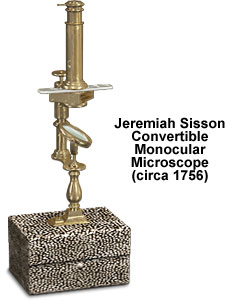Jeremiah Sisson Convertible Monocular Microscope
A striking base box covered in fish skin distinguishes the Jeremiah Sisson convertible microscope from its eighteenth century competitors. The combination simple and compound monocular model featured below was redrawn from photographs of the original microscope, which is part of the Billings Microscope Collection at Walter Reed Army Hospital in Washington DC.

Based on the 1756 design of Dr. Stephen C.T. Demainbray, who was the personal astronomer of King George III at Kew, Jeremiah Sisson crafted the elegant, but precise scientific instrument from brass, wood, glass, and fish skin. Sisson, who was an eighteenth century British instrument maker and son of Jonathan Sisson (another renowned optics craftsman), was well known for his geodetic and astronomical devices built in the London workshop of George Graham. The brass microscope features a sliding bar of objective lenses below the compound body, a draw tube, and a sliding lens cap. Demainbray did not include a field lens in his microscope plans, but designed a fixed stage with an opening for a spring box fitting for sliders, discs containing specimens, or the simple lens. A small concave mirror mounted on a brass rod, which inserts into the base pillar, serves as a reflector for illumination. Coarse focus is achieved with a dovetail slide mechanism mounted on a sliding rectangular rod within the microscope arm. At the top of the second pillar, and behind the body tube, a fine focus screw head is provided. In the closed position as a compound microscope, the height is 6.75 inches, while configured as a simple microscope, the height is a mere 4.5 inches.
During the seventeenth and eighteenth centuries, as an alternative to leather or vellum, fish skin (such as the rugged epidermis of sharks or stingrays), was used as a decorative and protective covering of microscopes and their accessories. Six objectives, a spring stage box for slides, tweezers, a lens or disc holder, an ivory disc of specimens, a fish plate, a stage forceps with discs, and a single lens are stored in the accessory box. The base box is signed "Dr. Demainbray, Invent." and "J. Sisson, London". Although both father and son signed their instruments in the same manner, the convertible simple and compound microscope is attributed to the son based on the design date.
BACK TO EIGHTEENTH CENTURY MICROSCOPES
